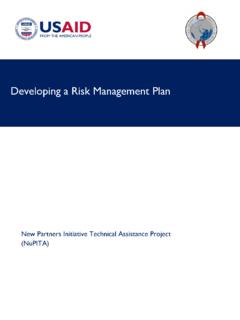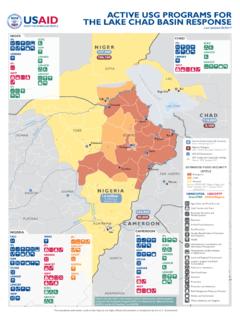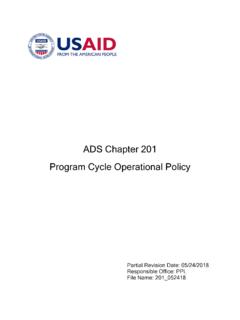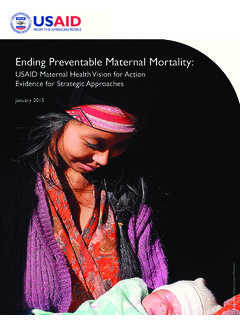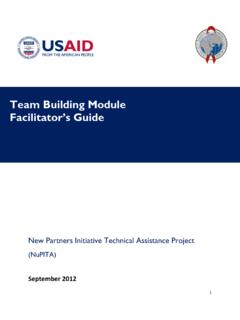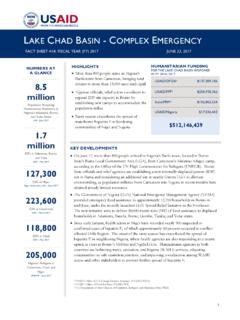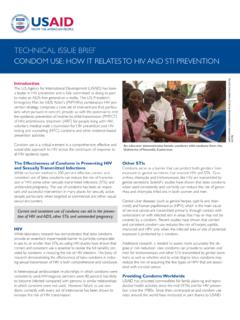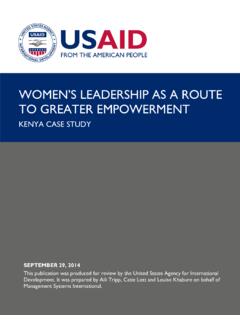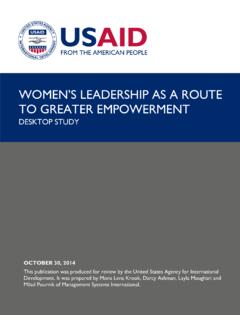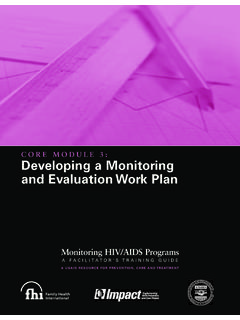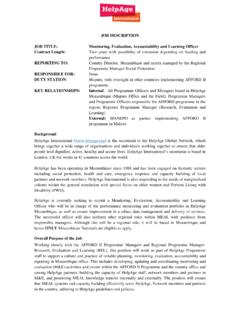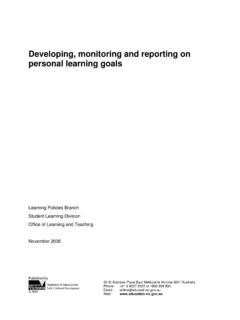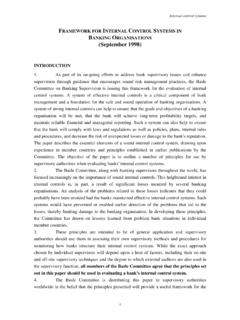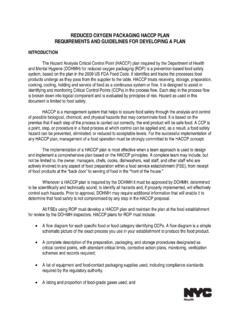Transcription of Monitoring and Evaluation Training Curriculum
1 Monitoring and Evaluation Training Curriculum 2009 New Partners Initiative Technical Assistance (NuPITA) Project NuPITA John Snow, Inc. 44 Farnsworth Street Boston, MA 02210-1211 Phone: The New Partners Initiative Technical Assistance (NuPITA) project is funded by the United States Agency for International Development (USAID) through Contract No: GHS-I-00-07- 00002-00. The Technical Assistance Project to New Partners Initiative (TA-NPI) project is funded by the United States Department of Health and Human Services Centers for Disease Control and Prevention through Contract No: 200-2004-05316/Task Order 002.
2 Both projects are implemented by John Snow, Inc. in collaboration with Initiatives Inc. This document is made possible by the generous support of the American people through USAID and Department of Health and Human Services Centers for Disease Control and Prevention (CDC). The contents are the responsibility of John Snow, Inc., and do not necessarily reflect the views of USAID, CDC, or the United States Government. August 2012 John Snow, Inc. Table of Contents I. Introduction .. ii Overview .. iii II.
3 Session Guide .. 1 Session 1: Introduction and Objectives .. 1 Session 2: Stage 1 Planning .. 4 Session 3: Using a Case Study .. 6 Session 4: Developing an M&E Logic Framework .. 8 Session 5: Defining Indicators .. 10 Session 6: Logic Framework Presentation .. 14 Session 7: Stage 2 Data Collection .. 15 Session 8: Stage 3 Making Data Usable .. 18 Session 9: Stage 4 Using Data for Making Decisions .. 23 Session 10: Open Space .. 26 Session 11: M&E Plans .. 27 III. Appendices .. 29 Appendix A: Sample Agenda.
4 29 Appendix B: Facilitator's Guide .. 31 Role of Facilitators .. 31 Facilitator's Notes for Stage 1: Planning .. 32 Worksheet 1: Assessing Objectives .. 33 Case Study Module .. 35 Worksheet 37 Completing the M&E Logic Framework .. 38 Case Study Module .. 39 Worksheet 3: Indicators and Data Collection Part 1 .. 40 Facilitator's Notes for Stage 2: Data Collection ..41 Case Study Module 2 .. 41 Worksheet 3: Indicators and Data Collection Part 2 .. 42 Data Quality Scenarios (Case Study Module 2).
5 43 Facilitator s Notes for Stage 3: Making Data Useable .. 44 Case Study Module .. 44 Worksheet 4: Stakeholder Analysis .. 45 Case Study Module .. 46 Case Study Module .. 46 Worksheet 5: Practice Making Graphs .. 47 Facilitator's Notes for Stage 4: Using Data for Decision-Making .. 48 Worksheet 6: Follow-Up Action 49 M&E plan 50 Appendix C: Handouts .. 52 Worksheet 1: Objectives .. 52 Case Study Module .. 53 Worksheet 2A: M&E Logic Framework .. 56 Worksheet 2B: Logic 57 Case Study Module.
6 58 Worksheet 3: Indicators and Data Collection ..60 Case Study Module 2 .. 61 Case Study Module .. 64 Worksheet 4: Stakeholder Analysis .. 65 Case Study Module .. 66 Worksheet 5 .. 70 Case Study Module 4 .. 71 Worksheet 6: Follow-Up Action 75 Evaluation of M&E Training .. 76 Appendix D: Session Slides .. 77 I. Introduction Preface The PEPFAR-supported Technical Assistance to the New Partners Initiative (TA-NPI) and the New Partners Initiative for Technical Assistance (NuPITA) projects, implemented by John Snow, Inc.
7 , with support from its subcontractor Initiatives Inc., provided technical and organizational capacity assistance to strengthen 27 NPI partners. Funding for TA-NPI came through the US Centers for Disease Control and Prevention (CDC) by the Department of Health and Human Services (HHS), while NuPITA was funded by USAID. The projects goal was to work with the NPI prime partners and their sub-partners in Africa and Haiti to enable them to: Manage USG grants and comply with USG regulations; Develop into stronger entities positioned to source new funding; and Implement quality HIV programs.
8 The projects used a number of strategies to build the capacity of these faith-based, community-based and international non-governmental organizations, including facilitating organizational capacity assessments to identify management system strengths and gaps, and technical capacity assessments to ensure service delivery and infrastructure standards were in place and monitored; group and organization-specific trainings; short-term technical assistance and embedded long-term advisors; state of the art updates; strategic planning to strengthen long-term planning; and continual mentoring and coaching from the projects teams of specialists.
9 TA-NPI documents are available at , and ; NuPITA products can be accessed at and TA NPI Curricula NuPITA Curricula Governance Resource Mobilization Strategic Planning Quality Improvement Referrals and Networking Information on Decision Making Human Resource Management Senior Management Gender and Culture Resource Mobilization Supportive Supervision Performance Appraisal Team Building Workplanning Quality Improvement Monitoring and Evaluation ii Overview A. Purpose The purpose of this Training is to review the four stages in a Monitoring and Evaluation (M&E) system: planning, data collection, making data usable and using data for decision-making to help organizations reflect on and strengthen their plans.
10 B. Audience The workshop is designed for staff members who are involved in collecting, analyzing or presenting M&E data ( , supervisors, program staff, community workers and management). It is helpful to have at least two or three representatives from the same organization attend the workshop. C. Learning objectives By the end of the workshop, participants will be able to: 1. Describe and understand the four stages in an M&E system 2. Develop a framework that links project activities to outcomes and impacts (goals) 3.
